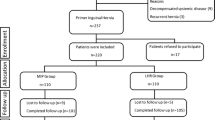Abstract
The aim of this prospective study was to set up and evaluate a technique allowing, by the mean of a memory ring, easy placement of the patch in the preperitoneal space (PPS), directly via the hernia orifice, so as to associate the advantages of the preperitoneal patch, anterior approach and minimally invasive surgery. The memory-ring patch was made by basting a PDS cord around a 14×7.5 cm oval shaped polypropylene mesh. The hernia sac was dissected, blunt dissection of the PPS was carried out through the hernia orifice and the patch was introduced in the PPS via the orifice. Spreading of the patch in the PPS was facilitated by the memory-ring. One hundred and twenty nine hernias, classified as Nyhus Type IIIa, IIIb and IV, were operated on 126 patients; 11 were big pantaloon or sliding hernias. The anesthesia was spinal in 116 cases and local in 10 cases. There were three benign postoperative complications (2.3%) related to the hernia repair. Ninety six percent of the patients were evaluated with a mean follow up of 24.5 months (12–42). Two recurrences (1.6%) occurred, 7 patients (5.6%) felt some degree of light pain, but not any case of disabling pain was observed. This technique offers many advantages. It is tension-free and almost sutureless. The patch is placed in the PPS through the hernia orifice without any remote opening in the abdominal wall. The patch applied directly to the deep surface of the fascia reinforces the weak inguinal area by restoring the normal anatomic disposition. The good preliminary results are encouraging and justify further randomized evaluation.





Similar content being viewed by others
References
Stoppa R, Petit J, Abourachid H (1973) Procédé original de plastie des hernies de l’aine : l’interposition sans fixation d’une prothèse en tulle de Dacron par voie médiane sous-péritonéale. Chirurgie 99:119–123
Rives J, Lardennois B, Flament JB, Convers G (1973) La pièce en tulle de Dacron, traitement de choix des hernies de l’aine de l’adulte. A propos de 183 cas Chirurgie 99:564–575
Nyhus LM, Pollack R, Bombeck CT, Donahue PE (1988) The preperitoneal approach and prosthetic buttress repair for recurrent hernia. Ann Surg 208:733–737
Schmedt CG, Sauerland S, Bittner R (2005) Comparison of endoscopic procedures vs Lichtenstein and other open mesh techniques for inguinal hernia repair: a meta-analysis of randomized controlled trials. Surg Endosc 19:189–99
EU Hernia Trialists Collaboration (2000) Laparoscopic compared with open methods of groin hernia repair: systematic review of randomized controlled trials. Br J Surg 87:860–867
Neumayer L, Globbie-Hurder A, Jonasson O, Fitzgibbons R, Dunlop D, Gibbs J, Reda D, Henderson W (2004) Open mesh versus laparoscopic mesh repair of inguinal hernia. N Engl J Med 350:1819–1827
Avisse C, Palot JP, Flament JB (1993) Traitement des hernies de l’aine par la technique de Jean Rives. Remplacement du fascia transversalis par une prothèse de Dacron. Chirurgie 119:362–365
Muldoon RL, Marchant K, Johnson DD, Yoder GG, Read RC, Hauer- Jensen (2004) Lichtenstein versus anterior preperitoneal prosthetic mesh placement in open inguinal hernia repair: a prospective, randomized trial. Hernia 8:98–103
Gilbert AI (1995) Day surgery for inguinal hernia. Int Surg 80:4–8
Kugel R (1999) Minimally invasive, nonlaparoscopic, preperitonral and sutureless, inguinal herniorraphy. Am J Surg 178:298–302
Nyhus LM (1994) A classification of groin hernia. In: Arregui ME, Nagan RF (eds) Inguinal hernia. Advances or controversies?. Radcliffe Medical Press, Oxford, pp 99–102
Nyhus LM (2000) Ubiquitous use of prosthetic mesh in inguinal hernia repair: the dilemma. Hernia 4:184–186
Pelissier EP, Blum D, Marre P, Damas JM (2001) Inguinal hernia: a patch covering only the myopectineal orifice is effective. Hernia 5:84–87
Read RC, Gilbert AI (2004) Interstitial recurrence with chronic inguinodynia after Lichtenstein herniorraphy. Hernia 8:264–267
Pelissier EP, Blum D, Elhaimeur A, Marre P, Damas JM (2000) Groin hernias: features of recurrences. Hernia 4:89–93
Glassow F (1973) The surgical repair of inguinal and femoral hernias. Can Med Assoc J 3:308–313
Aasvang E, Kehlet H (2005) Surgical management of chronic pain after inguinal hernia repair. Br J Surg 92:795–801
Kumar S, Wilson RG, Nixon SJ, Macintyre MC (2002) Chronic pain after laparoscopic and open mesh repair of groin hernia. Br J Surg 89:1476–79
Author information
Authors and Affiliations
Corresponding author
Rights and permissions
About this article
Cite this article
Pélissier, E.P. Inguinal hernia: preperitoneal placement of a memory-ring patch by anterior approach. Preliminary experience. Hernia 10, 248–252 (2006). https://doi.org/10.1007/s10029-006-0079-1
Received:
Accepted:
Published:
Issue Date:
DOI: https://doi.org/10.1007/s10029-006-0079-1



